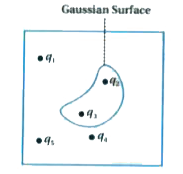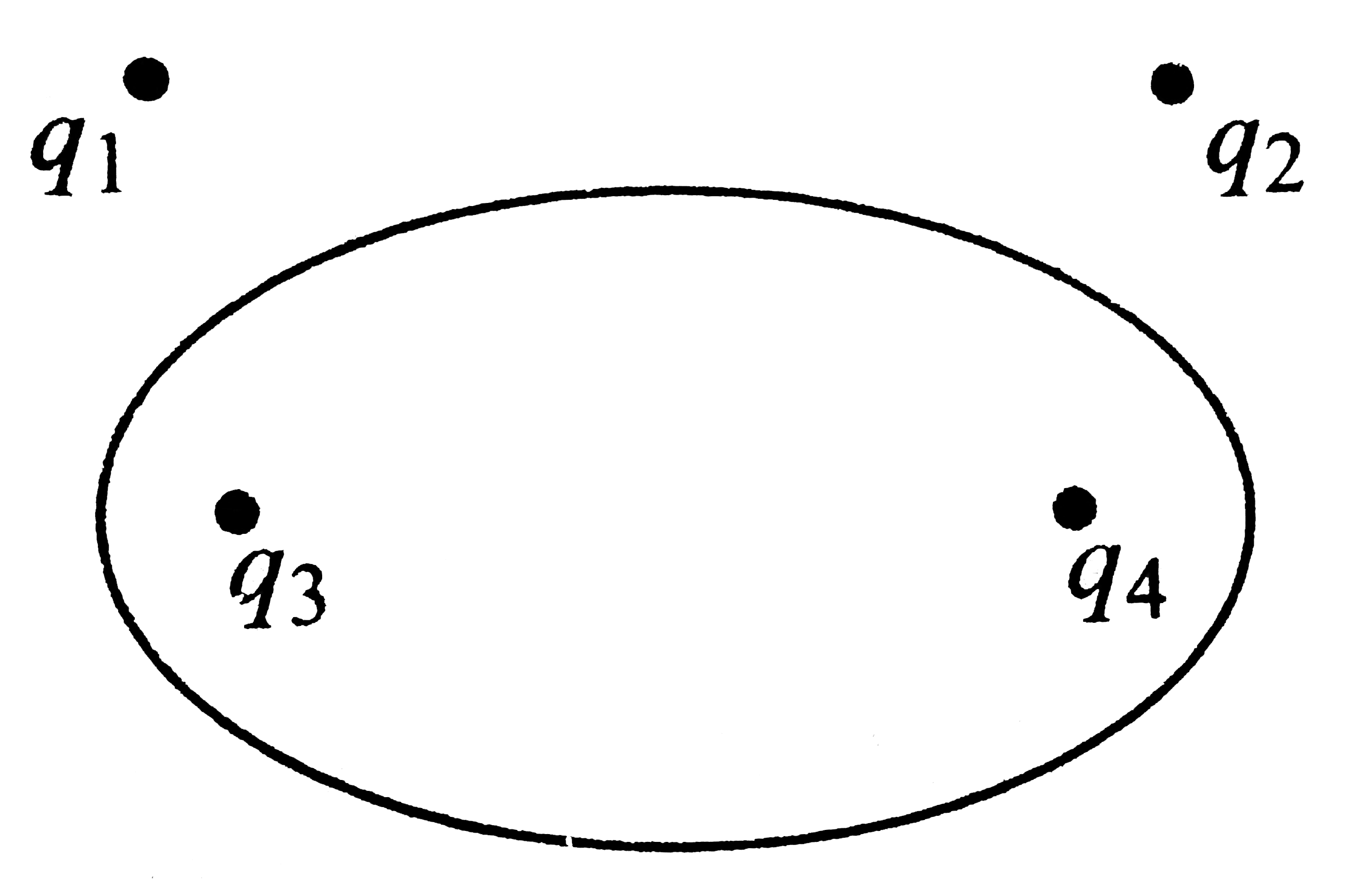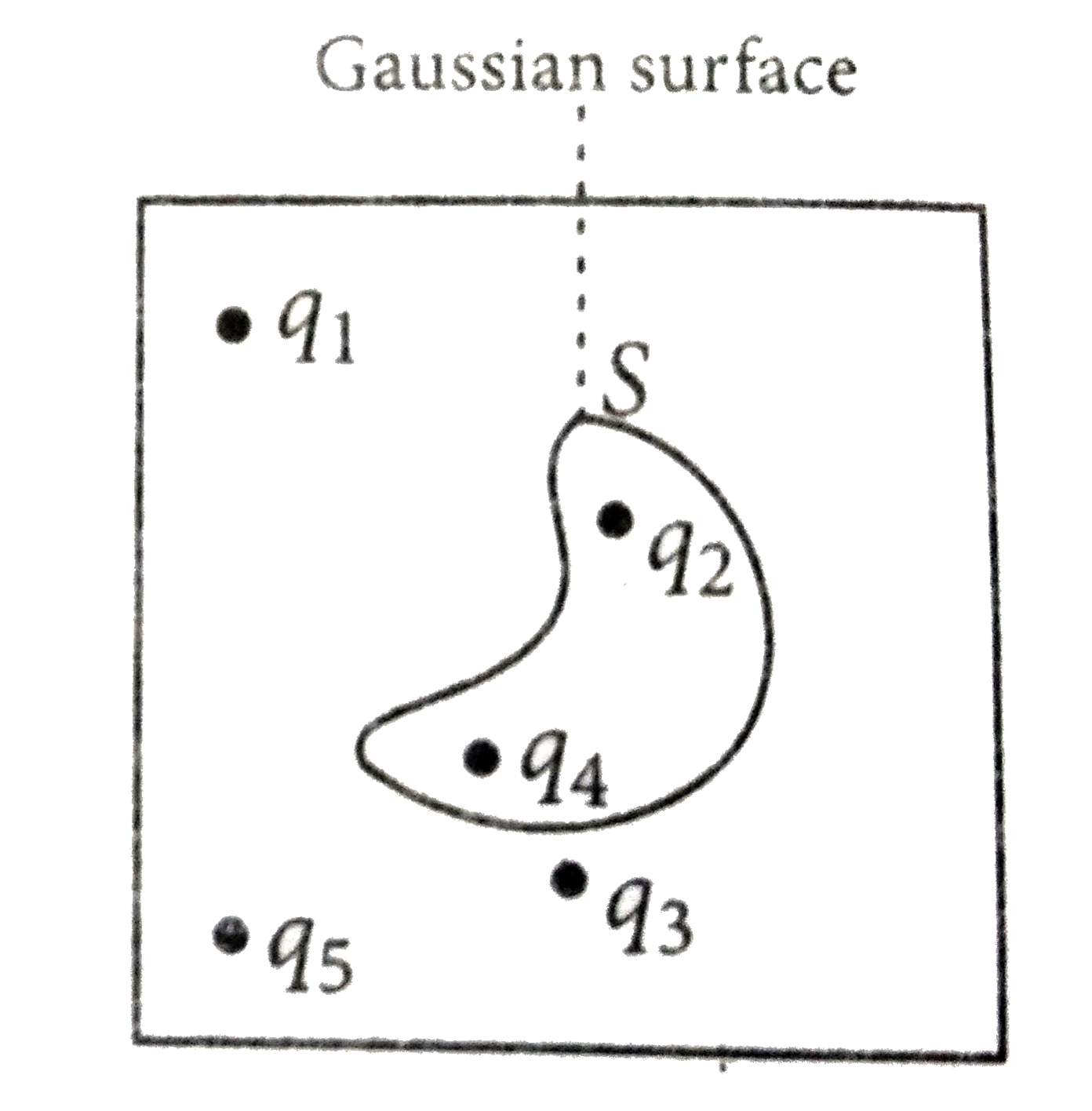Five charges q1q2,q3,q4, and q5 are fixed at their positions as shown in figure. S is a Gaussian surface. The Gauss's law is given by ∫S→E.→ds=qε0. Which of the following statements is correct?
 Solution in Gujrati
Solution in Gujrati
→E on the LHS of the above equation will have a contribution from q1,q5 and q3 while q on the RHS will have a contribution from q2 and q4 only.
→E on the LHS of the above equation will have a contribution from all charges while q on the RHS will have a contribution from q2 and q4 only.
→E on the LHS of the above equation will have a contribution from all charges while q on the RHS will have a contribution from q1,q3 and q5 only.
Both →E on the LHS and q on the RHS will have contributions from q2 and q4 only.
The correct Answer is:B
n equation, →E is electric field on closed surface by charges inside or outside it.
But, q1 is the charge enclosed by the closed surface, the charges outside the surface are not taken into consideration.
Topper's Solved these Questions
- ELECTRIC CHARGES AND FIELDS BOOK - KUMAR PRAKASHANCHAPTER - ELECTRIC CHARGES AND FIELDS EXERCISE - SECTION C NCERT EXEMPLAR SOLUTION (MULTIPLE CHOICE QUESTIONS (MORE THAN ONE OPTION))
6 Videos
- ELECTRIC CHARGES AND FIELDS BOOK - KUMAR PRAKASHANCHAPTER - ELECTRIC CHARGES AND FIELDS EXERCISE - SECTION C NCERT EXEMPLAR SOLUTION (VERY SHORT ANSWER TYPE QUESTIONS)
6 Videos
- ELECTRIC CHARGES AND FIELDS BOOK - KUMAR PRAKASHANCHAPTER - ELECTRIC CHARGES AND FIELDS EXERCISE - SECTION B NUMERICALS (NUMERICAL FOR .DARPAN. BASED ON TEXTBOOK)
8 Videos
- DUAL NATURE OF RADIATION AND MATTERBOOK - KUMAR PRAKASHANCHAPTER - DUAL NATURE OF RADIATION AND MATTEREXERCISE - Section-D (MCQs asked in GUJCET/Board Exam)
1 Videos
- ELECTROMAGNETIC INDUCTIONBOOK - KUMAR PRAKASHANCHAPTER - ELECTROMAGNETIC INDUCTIONEXERCISE - Section D MCQs (MCQs asked in Competitive Exams )
38 Videos
Similar Questions
If ∮s→E.→dS=0 over a surface, then
View SolutionAn arbitrary surface encloses a dipole. What is the electric flux through this surface ?
View SolutionTwo spheres of copper, having mass 1 g each, are kept 1 m apart. The number of electrons in them are 1 % less than the number of protons. The electrical force between them is Atomic wt. of copper is 63.54 g/mol, atomic number is 29, Avogadro's number NA=6.023×1023mol−1 and k=9×109 SI
View SolutionMass of photon in motion is ………
View SolutionThree pure inductance each of 3 H are connected as shown in figure. The equivalent inductance of this connection between points A and B is ......

View SolutionThree charges -q_1 , +q_2 and -q_3 are placed as shown in the figure. The x-component of the force on -q_1 is proportional to
View SolutionFigure shows four charges q1,q2,q3,andq4 fixed is space. Then the total flux of the electric field through a closed surface S, due to all the charges, is

View SolutionConsider Gauss's law
∮→E⋅→ds=qε0
Then, for the situation shown in figure at the Gaussian surface

View Solutionfive charge q_(1),q_(2),q_(3),q_(4) and q_(5) are fixed at their positions as shown in figure . s is Gaussian surface .The Gauss's law is given by ointvec(E).vec(ds)=(q)/(epsilon_(0)) Which of the following statement is correct?
View SolutionThe value of charge q_1 ,q_2 and q_3 as shown in the figure are
View SolutionEfficiency of cyclic process is 50%ifheatQ_1=19J,Q_2=40J,Q_3=125J,thenQ_4 is unknown then findthe value of Q4.
View SolutionThe electric flux Gaussian for surface A that enclose the charged particles in free space is (given q_1 =- 14 nC , q_2 = 78.85 nc ,q_3 =- 56 n C
View Solutionfive charge q_(1),q_(2),q_(3),q_(4) and q_(5) are fixed at their positions as shown in figure . s is Gaussian surface .The Gauss's law is given by ointvec(E).vec(ds)=(q)/(epsilon_(0)) Which of the following statement is correct?
View SolutionEfficiency of cyclic process is 50% if heat Q1=1915J , Q2=−40J , Q3=125J, then Q4 is unknown then find the value of Q4.
View SolutionFive charges q1,q2,q3,q4andq5 are fixed at their positions as shown in figure. S is Gaussian surface. The Gauss's law is given by ∮→ES⋅→ds=qε0. Which of the following statements is correct?

View Solution
